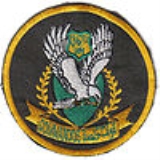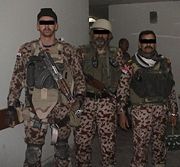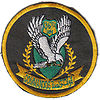
Iraqi 36th Commando Battalion
Encyclopedia
The Iraqi 36th Commando Battalion (36th CDO BN) is one of several Iraqi Special Operations Units that have emerged since the fall of the Saddam Hussein
Regime. Originally part of the Iraqi Special Operations Forces
Brigade (ISOF BDE), this aggressive unit has a role comparable to that of the United States Army Rangers
in the War on terror
. The unit is now designated the 1st Commando Battalion, part of the 1st Special Operations Brigade.
Commonly confused with other units that called themselves Commandos after the creation of the 36th Commandos; this unit is one of the most combat experienced/proven units in the new Iraqi Army.
(CPA), the Commander United States Central Command
(CDRCENTCOM), the Commander Combined Joint Task Force 7
(CDR CJTF-7), and the Iraqi Governing Council
(IGC). These elements agreed to form a Baghdad
-based, 500-man battalion by integrating militiamen from five (5) Political Parties: Iraqi National Accord
(INA), Iraqi National Congress
(INC), Kurdish Democratic Party (KDP), Patriotic Union of Kurdistan
(PUK), and Supreme Council for Islamic Revolution in Iraq (SCIRI). The men would be well-trained, physically fit, and would serve the new Iraqi nation and not just one party. The battalion would initially be treated as an Iraqi Civil Defense Corps (ICDC) unit under 1st Armored Division
(1 AD) control, but eventually it would be transferred to Iraqi control. The battalion was given the unit designation of the 36th CICDC (Composite-ICDC).
The challenge was to have this unit operational in one month (26 December 2003). CDRCENTCOM tasked CJSOTF-AP to attach USSF advisors with this battalion and develop this new type of ICDC operations. FOB 51 1st Bn. 5th SFG (A) re-tasked AOB 520, ODB (-), three ODA’s(-) and 1 full ODA from performing Unconventional Warfare(UW) and Direct Action (DA) missions to standing up the 36th ICDC Battalion. Split teams lined up with 4 Infantry Companies, plus a Scout and HQ Platoon; 521- A co., 523- B co., 524- C co., 533- D co., 533- Scouts and 520- HQ. AOB 520 CDR, MAJ John was the OIC with MSG Ron, 533 Team Sgt. as the NCOIC.
3 December 2003, the 5 Iraqi Political parties sent their militiamen to Camp Dogwood
, located approx. 20 km south of Baghdad, for 1 week of basic training. This phase consisted of unit assignment, medical screening, and basic soldier skills. After completion of this phase they moved to Camp Falcon, south Baghdad, where the unit received 2 weeks of Advanced Operations training. This phase focused on patrolling, CQB techniques, urban movement, and development of primary/subordinate leaders. Towards the end of this phase, ODA 535 and a Split team from ODA 534 replaced the split teams from 521, 523 and 524; 535- A co., 535- B co., 533- C co., 533- D co., 534- Scouts and 520- HQ. The Scout NCOIC was SFC Brett Walden, who paid the ultimate price for Iraq’s Freedom in the summer of 2005 in the Nineveh Province on a separate engagement.
CJSOTF-AP met the timeline with the graduation of the 36th CICDC Bn. and A co. conducting the new fielded units first combat reconnaissance patrol on the night of the 26 December 2003. The Companies were assigned AO’s in Baghdad, which they relocated to with their split teams. The teams lived in the same quarters, eating, training and developing rapport with their assigned companies.
From 2004-2005, The 36th CICDC evolved into the 36th Commandos. Several ODA’s served with them, to include; ODA’s from 2nd Bn 5th Group, then 533/535/513 combined and some 10th Group teams. Over 1 year after graduation, they received the New Lithuanian uniforms (which they had been promised to receive at that graduation.) A 36th CICDC patch was made in the shape of Iraq using the colors of the Iraqi flag as a back drop and centered in green the number “36”. In the summer of 2004, ODA 533’s SFC Jade, SFC Steve and ODA 535’s SSG Matt, developed Commando school located at FOB 51 Headquarters on the Baghdad International Airport (BIAP) grounds. The school was located on property that was once used by Saddam Hussein as a private zoo/Palace. The Commando School focused on CQB, marksmanship, hand-to-hand combat, objective infiltration (to include fast roping from helicopters) and the character development of leaders/subordinate leaders.
had no other unit named Commandos. As their AO opened and missions took them to all parts of Iraq, the media followed. The success of the unit became known throughout Iraq. Many units changed their name from Special Forces to Commandos, including police units and other militias.



The Company patch was made into a sign with, “Serriah Al Icktaham Charlie” written in Arabic on top and Assault Company “Charlie” written in English on the bottom. When a new recruit showed up to the unit they were given the C co. patch, which was placed above the left chest pocket and an Iraqi flag, placed on his right shoulder. When a Commando went on his 1st Combat Operation with the unit, he received a “Kawat Al Hassa” or “Special Forces” tab on his left shoulder. This was a tab used during the Saddam Regime. When a Commando went on his 1st “Iktaham” or “Assault/Raid”, he was awarded a red shoulder lanyard, which was also used during the Saddam Regime, which was worn on his right shoulder.
Saddam Hussein
Saddam Hussein Abd al-Majid al-Tikriti was the fifth President of Iraq, serving in this capacity from 16 July 1979 until 9 April 2003...
Regime. Originally part of the Iraqi Special Operations Forces
Iraqi Special Operations Forces
Iraqi Special Operations Forces refers to the Iraqi special forces unit created by Coalition forces after the 2003 invasion. As of November 2009, the forces, directed by the Iraqi Counter-Terrorist Bureau, consist of the Iraqi Counter-Terrorist Command, which has two brigades subordinate to it...
Brigade (ISOF BDE), this aggressive unit has a role comparable to that of the United States Army Rangers
United States Army Rangers
United States Army Rangers are elite members of the United States Army. Rangers have served in recognized U.S. Army Ranger units or have graduated from the U.S. Army's Ranger School...
in the War on terror
War on Terror
The War on Terror is a term commonly applied to an international military campaign led by the United States and the United Kingdom with the support of other North Atlantic Treaty Organisation as well as non-NATO countries...
. The unit is now designated the 1st Commando Battalion, part of the 1st Special Operations Brigade.
Commonly confused with other units that called themselves Commandos after the creation of the 36th Commandos; this unit is one of the most combat experienced/proven units in the new Iraqi Army.
History of the 36th CDO BN
On 25 November 2003 a decision was made between the Coalition Provisional AuthorityCoalition Provisional Authority
The Coalition Provisional Authority was established as a transitional government following the invasion of Iraq by the United States and its allies, members of the Multi-National Force – Iraq which was formed to oust the government of Saddam Hussein in 2003...
(CPA), the Commander United States Central Command
United States Central Command
The United States Central Command is a theater-level Unified Combatant Command unit of the U.S. armed forces, established in 1983 under the operational control of the U.S. Secretary of Defense...
(CDRCENTCOM), the Commander Combined Joint Task Force 7
Combined Joint Task Force 7
Combined Joint Task Force 7 was the interim military formation that directed the U.S. effort in Iraq between June 2003 and May 2004. It replaced the Coalition Forces Land Component Command on 14 June 2003. CFLCC was the land forces component of United States Central Command that carried out the...
(CDR CJTF-7), and the Iraqi Governing Council
Iraqi Governing Council
The Iraqi Governing Council was the provisional government of Iraq from July 13, 2003 to June 1, 2004. It was established by and served under the United States-led Coalition Provisional Authority...
(IGC). These elements agreed to form a Baghdad
Baghdad
Baghdad is the capital of Iraq, as well as the coterminous Baghdad Governorate. The population of Baghdad in 2011 is approximately 7,216,040...
-based, 500-man battalion by integrating militiamen from five (5) Political Parties: Iraqi National Accord
Iraqi National Accord
The Iraqi National Accord known inside Iraq as Wifaq is an Iraqi political party founded by Iyad Allawi and Salah Omar Al-Ali in 1991. Al-Ali subsequently left the party after he realised the extent of Allawi's links to foreign intelligence agencies, mainly the C.I.A. and MI6.It was founded at the...
(INA), Iraqi National Congress
Iraqi National Congress
The Iraqi National Congress is an umbrella Iraqi opposition group led by Ahmed Chalabi. It was formed with the aid and direction of the United States government following the Gulf War, for the purpose of fomenting the overthrow of Iraqi leader Saddam Hussein.-History:INC was set up following the...
(INC), Kurdish Democratic Party (KDP), Patriotic Union of Kurdistan
Patriotic Union of Kurdistan
The Patriotic Union of Kurdistan is a Kurdish political party in Iraqi Kurdistan. The Patriotic Union of Kurdistan was founded on June 1, 1975, by coordinations between Jalal Talabani and Nawshirwan Mustafa...
(PUK), and Supreme Council for Islamic Revolution in Iraq (SCIRI). The men would be well-trained, physically fit, and would serve the new Iraqi nation and not just one party. The battalion would initially be treated as an Iraqi Civil Defense Corps (ICDC) unit under 1st Armored Division
1st Armored Division (United States)
The 1st Armored Division—nicknamed "Old Ironsides"—is a standing armored division of the United States Army with base of operations in Fort Bliss, Texas. It was the first armored division of the U.S...
(1 AD) control, but eventually it would be transferred to Iraqi control. The battalion was given the unit designation of the 36th CICDC (Composite-ICDC).
The challenge was to have this unit operational in one month (26 December 2003). CDRCENTCOM tasked CJSOTF-AP to attach USSF advisors with this battalion and develop this new type of ICDC operations. FOB 51 1st Bn. 5th SFG (A) re-tasked AOB 520, ODB (-), three ODA’s(-) and 1 full ODA from performing Unconventional Warfare(UW) and Direct Action (DA) missions to standing up the 36th ICDC Battalion. Split teams lined up with 4 Infantry Companies, plus a Scout and HQ Platoon; 521- A co., 523- B co., 524- C co., 533- D co., 533- Scouts and 520- HQ. AOB 520 CDR, MAJ John was the OIC with MSG Ron, 533 Team Sgt. as the NCOIC.
3 December 2003, the 5 Iraqi Political parties sent their militiamen to Camp Dogwood
Camp Dogwood
Camp Dogwood is the name of the base camp for the British Black Watch regiment in Iraq, 2004, located south of Baghdad.Camp Dogwood is also the name for a US FOB, further to the north of the original Camp Dogwood, from late 2004 to 2005, located between Fallujah and Karbala. It is also known as FOB...
, located approx. 20 km south of Baghdad, for 1 week of basic training. This phase consisted of unit assignment, medical screening, and basic soldier skills. After completion of this phase they moved to Camp Falcon, south Baghdad, where the unit received 2 weeks of Advanced Operations training. This phase focused on patrolling, CQB techniques, urban movement, and development of primary/subordinate leaders. Towards the end of this phase, ODA 535 and a Split team from ODA 534 replaced the split teams from 521, 523 and 524; 535- A co., 535- B co., 533- C co., 533- D co., 534- Scouts and 520- HQ. The Scout NCOIC was SFC Brett Walden, who paid the ultimate price for Iraq’s Freedom in the summer of 2005 in the Nineveh Province on a separate engagement.
CJSOTF-AP met the timeline with the graduation of the 36th CICDC Bn. and A co. conducting the new fielded units first combat reconnaissance patrol on the night of the 26 December 2003. The Companies were assigned AO’s in Baghdad, which they relocated to with their split teams. The teams lived in the same quarters, eating, training and developing rapport with their assigned companies.
From 2004-2005, The 36th CICDC evolved into the 36th Commandos. Several ODA’s served with them, to include; ODA’s from 2nd Bn 5th Group, then 533/535/513 combined and some 10th Group teams. Over 1 year after graduation, they received the New Lithuanian uniforms (which they had been promised to receive at that graduation.) A 36th CICDC patch was made in the shape of Iraq using the colors of the Iraqi flag as a back drop and centered in green the number “36”. In the summer of 2004, ODA 533’s SFC Jade, SFC Steve and ODA 535’s SSG Matt, developed Commando school located at FOB 51 Headquarters on the Baghdad International Airport (BIAP) grounds. The school was located on property that was once used by Saddam Hussein as a private zoo/Palace. The Commando School focused on CQB, marksmanship, hand-to-hand combat, objective infiltration (to include fast roping from helicopters) and the character development of leaders/subordinate leaders.
2006
Before the 36th Commandos, IraqIraq
Iraq ; officially the Republic of Iraq is a country in Western Asia spanning most of the northwestern end of the Zagros mountain range, the eastern part of the Syrian Desert and the northern part of the Arabian Desert....
had no other unit named Commandos. As their AO opened and missions took them to all parts of Iraq, the media followed. The success of the unit became known throughout Iraq. Many units changed their name from Special Forces to Commandos, including police units and other militias.

History of C co. 36th CDO BN
C co. 36th CICDC, found a home within the gates of the Ministry of Oil (MoO). On the backside of the grounds was a 3-storey building, which had been a day care for the children of the workers at the MOO. It had several rooms, multiple entrances and could be approached from several directions by multiple vehicles because of its location in the MoO parking lot. This served as an excellent training platform for CQB because this one building could be set up to mirror and be approached exactly like any target house/objective. Because most of the objectives were Raids, C co. 36th quickly adopted the name “Serriat Al Icktiham-Charlie” or Assault Company “Charlie”.36th CDO BN Insignia (incomplete)

36th Commando Battalion Unit Patch
The 36th Commando Bn. received a new unit patch badge, green and round in shape with an attacking eagle centered. This patch was worn on the left shoulder.
Commando School Badge
Upon graduation from Commando School the Commando received the Commando badge similar to the 36th CDO BN Unit Patch, a green rectangle with an Eagle with spread wings centered on it and written in English and Arabic was the title Commando. The badge was worn over the left chest pocket.C co. 36th CDO BN Insignia
They developed a Company patch and awards to signify unit members’ experience. The Company patch was a maroon rectangle with a white skull and cross bones centered on the rectangle. Maroon/red in Iraq was traditionally used for Special Forces.The Company patch was made into a sign with, “Serriah Al Icktaham Charlie” written in Arabic on top and Assault Company “Charlie” written in English on the bottom. When a new recruit showed up to the unit they were given the C co. patch, which was placed above the left chest pocket and an Iraqi flag, placed on his right shoulder. When a Commando went on his 1st Combat Operation with the unit, he received a “Kawat Al Hassa” or “Special Forces” tab on his left shoulder. This was a tab used during the Saddam Regime. When a Commando went on his 1st “Iktaham” or “Assault/Raid”, he was awarded a red shoulder lanyard, which was also used during the Saddam Regime, which was worn on his right shoulder.

